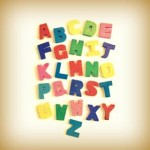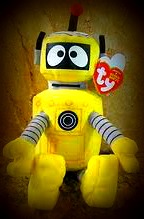 In typical development, usually around the age of 12 months of age, the child discovers a new way to deal with uncertainty. When confronted with a new object, person, or task, he realizes he is feeling uncertainty but is not afraid. He starts to trust a more experienced guide to help him understand the world. He recognizes that he can study unfamiliar objects, persons, or tasks to determine whether to engage with them. He checks in with the guide to decide how to react to the new thing. This is easily seen in an infant when he looks at his mother when a new toy is placed on the floor. Mom smiles at him and the reassured baby reaches out to touch the toy. If mom had frowned or acted scared, the baby would realize that he should be wary or afraid.
In typical development, usually around the age of 12 months of age, the child discovers a new way to deal with uncertainty. When confronted with a new object, person, or task, he realizes he is feeling uncertainty but is not afraid. He starts to trust a more experienced guide to help him understand the world. He recognizes that he can study unfamiliar objects, persons, or tasks to determine whether to engage with them. He checks in with the guide to decide how to react to the new thing. This is easily seen in an infant when he looks at his mother when a new toy is placed on the floor. Mom smiles at him and the reassured baby reaches out to touch the toy. If mom had frowned or acted scared, the baby would realize that he should be wary or afraid.
Our kids on the autism spectrum miss this milestone. Despite the many differences along the autism spectrum, this lack of perspective-borrowing is universal. Teaching our kids this crucial skill is a fundamental component of RDI. It is not easy because by missing this skill, the child learns to react with fear and rigid control of situations, thus severely limiting their ability to learn and interact with others and situations. Continue reading
 Zip and I keep working on patterns in putting things in or out of things. He’s definitely got the idea but doesn’t reference me much yet. A few days ago, we began to put clothes in the washing machine. Instead of putting the basket right next to the washer, I left it a foot or two away. Now, Zip and I were in true assembly-line. I gave him the role of handing me the clothes and he really took it on. Sounds silly, but in this position, it made it clearer to him and he carefully handed me each item. Since we could face each other now, he paid much more attention to me and made sure I got each item. Other times, he hasn’t seemed to notice whether I dropped it or got it.
Zip and I keep working on patterns in putting things in or out of things. He’s definitely got the idea but doesn’t reference me much yet. A few days ago, we began to put clothes in the washing machine. Instead of putting the basket right next to the washer, I left it a foot or two away. Now, Zip and I were in true assembly-line. I gave him the role of handing me the clothes and he really took it on. Sounds silly, but in this position, it made it clearer to him and he carefully handed me each item. Since we could face each other now, he paid much more attention to me and made sure I got each item. Other times, he hasn’t seemed to notice whether I dropped it or got it. We haven’t been RDI-ing as much as we should since we’ve been in lazy summer mode. We’ve pretty much mastered our most recent Child objective where Zip and I have been working on pattern regulation so that’s very very exciting. I’ve been giving him more of a role in the patterns and he’s been mostly handling it quite well. We can see him thinking and considering what we’re doing. Wonderful!
We haven’t been RDI-ing as much as we should since we’ve been in lazy summer mode. We’ve pretty much mastered our most recent Child objective where Zip and I have been working on pattern regulation so that’s very very exciting. I’ve been giving him more of a role in the patterns and he’s been mostly handling it quite well. We can see him thinking and considering what we’re doing. Wonderful! Hope you don’t have too many of those! Anyway, Zip and I were playing with some Yo Gabba Gabba stuffed toys. I was doing most of the work, being silly, and making funny noises with them. Zip had added “Sh” with his finger to his lips while giggling. Then he took the character’s hand and put it to it’s mouth while saying it. My heart be still – is that a little pretend play I’m seeing? <big grin>
Hope you don’t have too many of those! Anyway, Zip and I were playing with some Yo Gabba Gabba stuffed toys. I was doing most of the work, being silly, and making funny noises with them. Zip had added “Sh” with his finger to his lips while giggling. Then he took the character’s hand and put it to it’s mouth while saying it. My heart be still – is that a little pretend play I’m seeing? <big grin> I have to admit that I didn’t learn to study until I went to college, and boy, was that a rude awakening! Thankfully, we’re not talking about hitting the books in our newest RDI objective. Instead, our consultant wants to see and hear about Zip studying what to do. This goes along with him beginning to recognize patterns. I need to start noticing when he thinks about a situation where he is not sure what to do.
I have to admit that I didn’t learn to study until I went to college, and boy, was that a rude awakening! Thankfully, we’re not talking about hitting the books in our newest RDI objective. Instead, our consultant wants to see and hear about Zip studying what to do. This goes along with him beginning to recognize patterns. I need to start noticing when he thinks about a situation where he is not sure what to do. We’ve learned the hard way that if you do the same thing in the same way, Zip will think that’s the only way and protest any changes. He gets stuck on certain things, like the same two pairs of fleece pajamas, even though before that he would only wear green cotton airplane pajamas. This may seem like pattern recognition but it’s just the autistic tendancy towards rigid thinking. Since we prefer him to have a more flexible approach to life, we try to change things up.
We’ve learned the hard way that if you do the same thing in the same way, Zip will think that’s the only way and protest any changes. He gets stuck on certain things, like the same two pairs of fleece pajamas, even though before that he would only wear green cotton airplane pajamas. This may seem like pattern recognition but it’s just the autistic tendancy towards rigid thinking. Since we prefer him to have a more flexible approach to life, we try to change things up. We had a great week last week. Zip is feeling so much more guid-able. Is that a word? Perhaps I should define it. Just in the last few weeks, Zip has begun listening to me, doing what I say, staying near me when we’re out. It’s a remarkable change. I have to chalk it up to Dynamic Listening.
We had a great week last week. Zip is feeling so much more guid-able. Is that a word? Perhaps I should define it. Just in the last few weeks, Zip has begun listening to me, doing what I say, staying near me when we’re out. It’s a remarkable change. I have to chalk it up to Dynamic Listening.